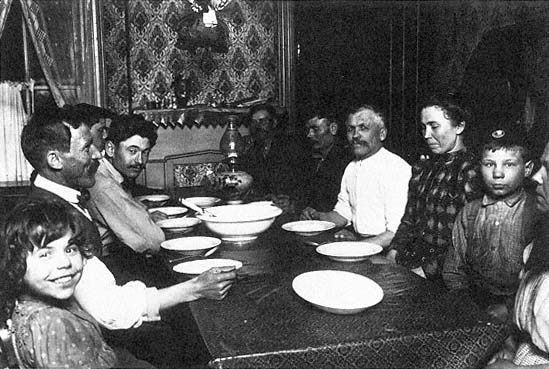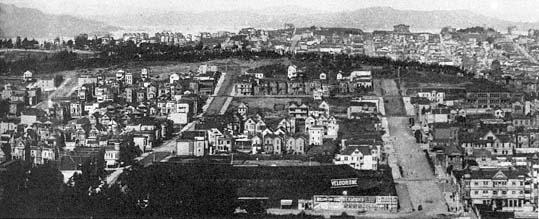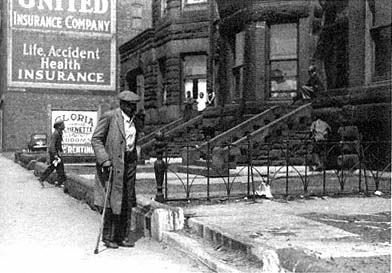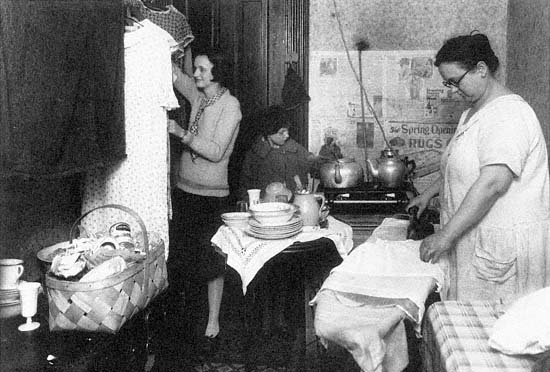Downtown Alternatives to Rooming Houses
At least according to social ideals, if roomers left rooming house life, they either joined the protective circle of a private family or began to cook for themselves. In so doing they stepped up in status. While living with a family or cooking for themselves they were less overtly dependent on commercial entertainment and public dining, and less involved with the tainting mixtures of rooming house districts. However, both family and apartment alternatives confronted rooming house residents with serious problems. Living with a family worked directly against the individualism so encouraged by work places and youth culture. The limited and erratic income of rooming house residents militated against proper apartment life. The apartment option that roomers could afford, the light housekeeping room, actually lowered their status.
Problems of Living with a Downtown Family
Boarding or lodging with a family was the major alternative to living in a commercial boardinghouse or rooming house, and it was also the most commonly chosen downtown life-style for young single men and women. For families in the middle and upper class, boarders were extra income, companionship, or people taken in as a favor to relatives. In such households, boarders often filled unused rooms. For wage-labor families with irregular incomes, boarders were essential. The income they

Figure 4.23
A Slavic boardinghouse dining room in a factory district near New York City, 1912. Photographed
by Lewis Hine.
provided helped to pay medical bills or make monthly payments on a looming seven-year mortgage with a balloon payment at the end. Boarding with families was particularly common in working-class family districts and family slums, often located next to rooming house districts because their residents depended on many of the same kinds of jobs (fig. 4.23).
Boarding with a family offered more traditional home-style conviviality, more social respectability, and generally better food than hotel life. Immigrants tended to board for only a short time and then set up independent households.[80] Unlike immigrants, American-born migrants to the city often chose boarding as a long-term housing choice. The eighteen-year-old lumber clerk, Will Kortum, had started his San Francisco life in a hotel in 1905 but soon wrote home that he planned to move in with a family in a nearby working-class district:
I am getting tired of this hotel and restaurant life and as soon as my pay is raised will look for board in a private family. . . . They say that . . . if you are lucky it is just like being at home.[81]

Figure 4.24
Flats and single-family houses at the edge of San Francisco, ca. 1890s. Roomers who stayed with families
in such settings were isolated from downtown life.
Kortum moved into a private boardinghouse on Eleventh Street, in the South of Market area, where he lived with the housekeepers—a young Swedish woman and her little girl—and seven other paying guests. He found that boarding with an immigrant family meant a sharp decline in personal comforts:
The meals are good, at least they are a great improvement in the restaurant fare, but otherwise there are but few comforts: no water in the room, poor bed, very small room, and bare of furniture. I shall look around for something better and wish I had never moved here at all.[82]
Kortum's new room supplied fewer personal needs independent of the boarding household. "My moving is an easily accomplished act," he said, "but costs 50 cents every time so I must be more careful."
This dissatisfaction with boarding with a family matched a general trend. Many boarders sought more independence and freer association with friends. Young people who lived in outlying family districts had a half-hour streetcar ride every time they wanted to visit companions, go dancing, or see a movie (fig. 4.24). Returning home, family boarders had to worry about missing the last streetcar for the night.[83] Other concerns were about privacy, as reported in this case:
"Miss G.," a public school music teacher, did not like rooming with a family. When she had phone calls, the family had to listen to one end of the conversation. If she slept late on Saturday morning she felt she was inconvenienc-
ing the family—and the children made such a ruckus she could not rest anyway. . . . She repeatedly took guests for a walk rather than use the parlor.[84]
Another woman complained, "The family from whom I rented a room were inquisitive and prying. I'm sure they investigated my room during my absence. The bathroom was occupied for prolonged periods."[85] Once these women had sampled the personal freedom and independence of hotel life, they felt that it would be impossible for them to board in a private home again. Lily Bart, Edith Wharton's heroine in The House of Mirth , eventually chose the anonymity of a commercial boardinghouse over living in a friend's house. To Lily, "the promiscuity of small quarters and close intimacy seemed, on the whole, less endurable than the solitude of a hall bedroom in a house where she could come and go unremarked among other workers."[86]
Light Housekeeping Rooms
Light housekeeping rooms were the cheap apartment-style alternative to rooming house life. They were typically one- or two-room suites in flimsily adapted former houses or apartments, usually in declining neighborhoods (fig. 4.25). By the 1920s, the hallmark of a housekeeping room was the "ubiquitous gas plate" on an old crate in a corner of the bedroom, with a rubber hose leading from it up to the wall gaslight fixture.[87] To keep cooking grease from splattering the wallpaper, tenants pinned newspaper against the wall. A pail of water might serve as a sink. There was usually an improvised pantry made by a large soap box, with cheap curtains on the front. Elsewhere, housekeeping meant simply that several tenants shared both kitchen and bath. Managers of light housekeeping units typically supplied a table, two chairs, a bureau, a few dishes, and a few cooking utensils.[88] As with rooming houses, daily management was left to resident women who leased the buildings as a business. By all accounts, housekeeping rooms were sanitary and social problems. They were technically not hotel units because of their cooking arrangements, although some surveys included them in the ranks of single-room occupancy. Even when owners borrowed names like "apartment hotel" or "residence club" for their furnished room buildings, the lineage of these operations led directly back to the worst nineteenth-century slum traditions. In 1939, two-fifths of San Francisco's substandard housing units were housekeeping rooms. The advantage for the landlord was

Figure 4.25
Kitchenette apartment buildings (light housekeeping rooms) on South
Parkway in Chicago, 1941.
income: a building cut into two-room units brought twice the monthly rental income that it produced as five-room flats.[89]
Housekeeping rooms were often crowded by families who had fallen on hard times; social workers called them "dejected families" (fig. 4.26). Unlike poor immigrant families in tenements, tenants in housekeeping rooms were usually born in America and often white. Their trip to housekeeping rooms began when they defaulted on the mortgage on their house, stored their furniture, and moved into some sort of hotel while the breadwinners recovered from illness, continued to drink, or looked for work. If the family's finances continued to decline, they often lost their furniture for nonpayment of storage fees.[90] Thus, they found themselves locked into life in housekeeping rooms. Other families came to choose it over the option of having a full-fledged apartment; when social workers helped them obtain a flat and furniture, the families moved right back into cheap furnished rooms. For such households, the social workers reserved the labels "shiftless" and "tramp families."[91]
More expensive apartments were usually out of the question for people in the rooming house price range. The barriers were entry costs and application barriers more than the monthly rents. Matrons in the YWCA cautioned that "it was a risky thing for two or three girls to take an apartment together" because "if one dropped out the remainder were then forced to bear the financial burden" until a new room-

Figure 4.26
Housework in light housekeeping rooms in Chicago, ca. 1929. Note the rubber tube connecting
the gas wall fixture to the hot plate.
mate could be found.[92] Even when respectable and inexpensive downtown apartments became more available, young single people had neither the nest egg nor the job security to buy the furniture, linens, and kitchen equipment that apartments required. Unmarried or poorly employed people also had a slim chance of getting a lease from apartment managers. Furnished one-room efficiency apartments solved some of these problems, but at $25 to $30 a month they were beyond economic reach. They outpriced an unfurnished four-room garden apartment in the suburbs (table 2, Appendix). So, until their income improved, the low-income renters stayed in housekeeping rooms or in a rooming house.